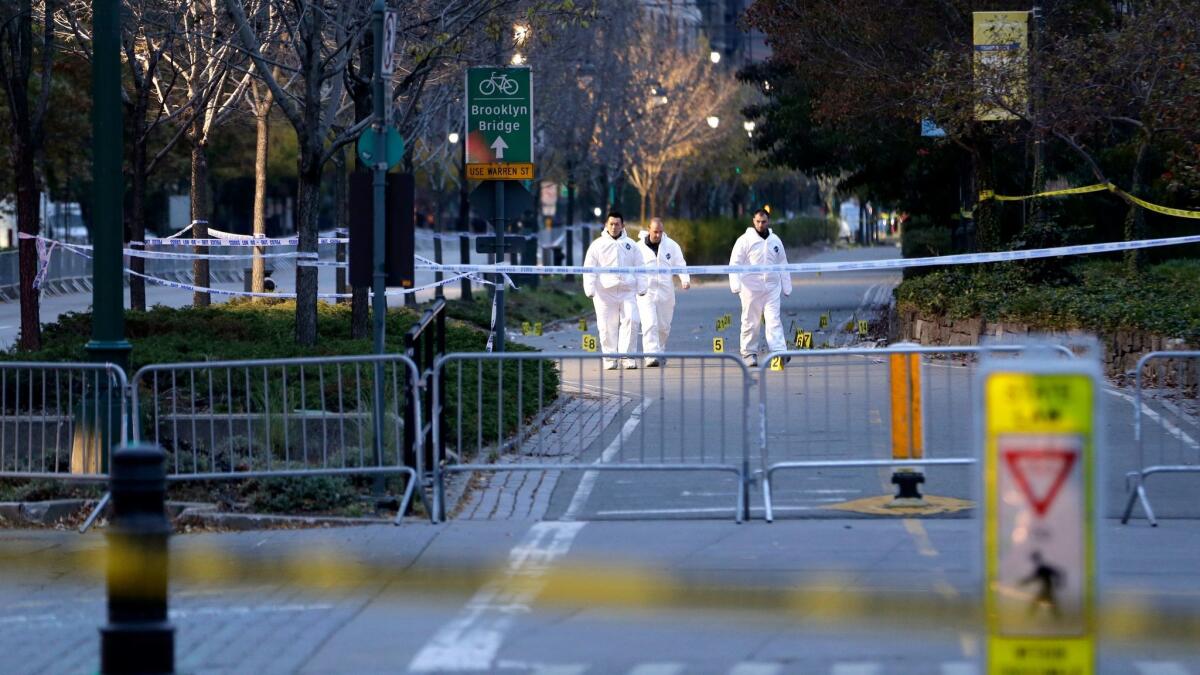Op-Ed: Yes, radical Islamic terrorism is different

- Share via
On Halloween, a 29-year-old New Jersey man plowed a rented truck into crowds of people on a bike path in Lower Manhattan, killing eight people. The attack was reportedly inspired by Islamic State, although no connections have yet been established between the attacker and any known terrorist organization. He entered the United States from Uzbekistan on a diversity visa in 2010, and appears to have been radicalized since then.
Sixteen years after Sept. 11, some dismiss concerns about radical Islamic terrorism as right-wing fear mongering or a Bush-era hangover. It is fashionable in certain quarters to deride the odds of any American being killed by Islamist terrorists, and to argue that purely homegrown terrorists — such as white supremacists — are a numerically larger problem. They claim we should all be more worried about mass shootings, like the recent atrocity in Las Vegas. But theirs is a too-narrow view of both the data and the nature of the threat.
“Radical Islam” is a set of political, not religious, beliefs. It compels its believers to make war not only against Israel, the West and India, but especially against Muslims who reject their political vision. That vision includes killing people who convert from Islam, brutally murdering homosexuals, the forcible subjugation of women and reclamation of any land that has ever been in Muslim hands. The political goal is to create and expand the kind of stark theocracy run by Islamic State or the Taliban.
Radical Islam is not the only source of terrorist attacks, hate crimes or mass shootings. But it is still by far the most dangerous.
These political doctrines are so dangerous precisely because they are preached to their believers as the religious commands of Islam, and can be hard for outsiders to untangle from more conventional Islamic teachings. Confusing the two is a goal of the radicals: It inflates their perceived numbers, intimidates anti-radical Muslims and invites backlash. The radicals are most likely a very small percentage of the world’s estimated 1.6 billion Muslims, but you can hide a lot of fish in such a large sea.
In some ways, atrocities by radical Islamists are like conventional hate crimes: They target groups of strangers, spreading fear of similar attacks far beyond their immediate targets. But comparing the raw number of casualties within the United States — and then excluding Sept. 11, as comparisons often do — significantly understates the threat in four important ways.
First, unlike mass shootings by unstable individuals, terror attacks happen for a reason that goes beyond the perpetrator. Because they come from ideas that are widely shared, they are more likely to be repeated than random attacks. And unlike extremist versions of Christianity or extremes of the American political left or right, radical Islamists can look to internationally prominent spokesmen who openly advocate violence.
Second, terrorism by nature is episodic; what looks like a small threat for a year or two can come roaring back. Data on radical Islamic terrorism in the United States in the 1990s would have gravely underestimated the threat that loomed in 2001. We know that radical Islamic terrorists continue to aim for mass-casualty attacks. Many have been thwarted by the very anti-terror policies that critics see as an overreaction. Accounting for the threat has to include the Sept. 11 attacks, because we deal with enemies who would love to repeat them.
Third, the radical Islamic movement is global, so any estimate of the threat should not treat terrorism in the United States as if it were walled off from the rest of the world. Tuesday’s attack, in which an Uzbek immigrant drew on radical ideas from Syria and Iraq, using a truck-attack tactic commonly used in Europe and the Middle East, reminds us of how quickly problems that seem far away can appear on our shores.
Fourth, radical Islam continues to draw on vastly larger resources — organizational and financial support, state sponsorship and the violent know-how gained in conflicts across the globe — than any other extremist movement in the world. Even major white nationalist groups pale in comparison (the closest they have to a major state patron is Russian President Vladimir Putin, and Putin’s preferred modus operandi is to boost groups involved in elections).
The government has resisted collecting data that classifies terrorist attacks by source, but the State Department’s annual reports on known terrorist organizations have long been dominated by radical Islamic groups. Its 2016 report yet again found that a majority of all terrorist attacks and deaths took place in seven countries (Iraq, Afghanistan, India, Pakistan, the Philippines, Syria and Nigeria), all targets of radical Islamic terror. Over the last decade, the State Department’s global toll of terrorism annually has ranged from 25,000 to 35,000 dead, an equal number injured, and perhaps half as many kidnapped or taken hostage.
Here in the United States, a 2017 study by the libertarian Cato Institute found that radical Islamist terrorists accounted for 92% of the deaths and 94% of the injuries due to terrorist attacks on U.S. soil over the last 25 years, the bulk of those in the Sept. 11 attacks.
Radical Islam is not the only source of terrorist attacks, hate crimes or mass shootings. But it is still by far the most dangerous.
Dan McLaughlin is an attorney in New York and a contributing columnist to National Review Online.
Follow the Opinion section on Twitter @latimesopinion or Facebook.
More to Read
A cure for the common opinion
Get thought-provoking perspectives with our weekly newsletter.
You may occasionally receive promotional content from the Los Angeles Times.










